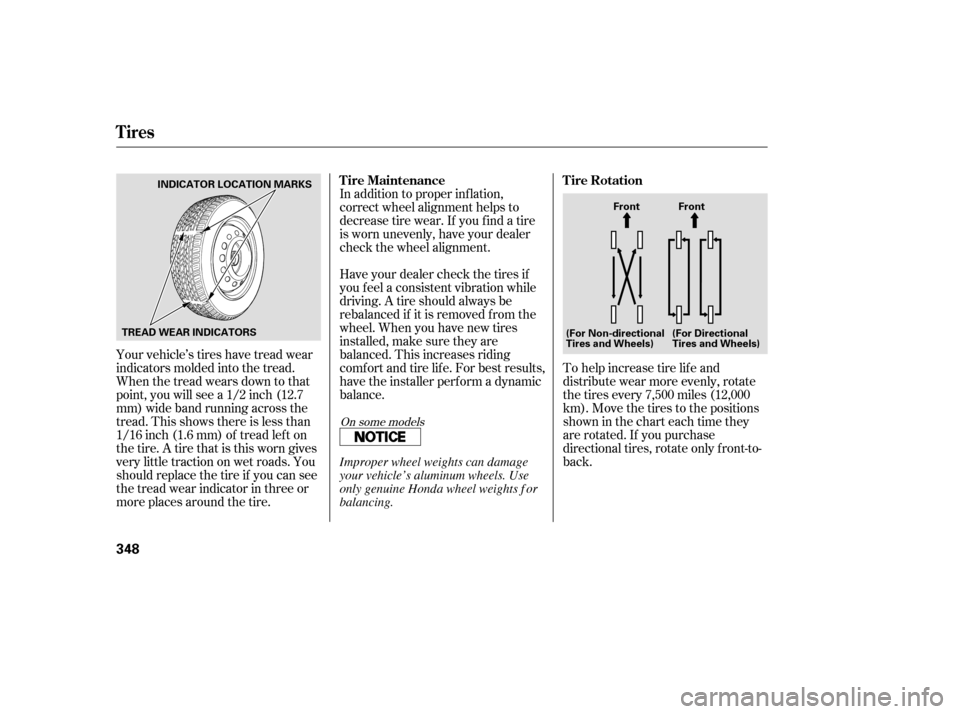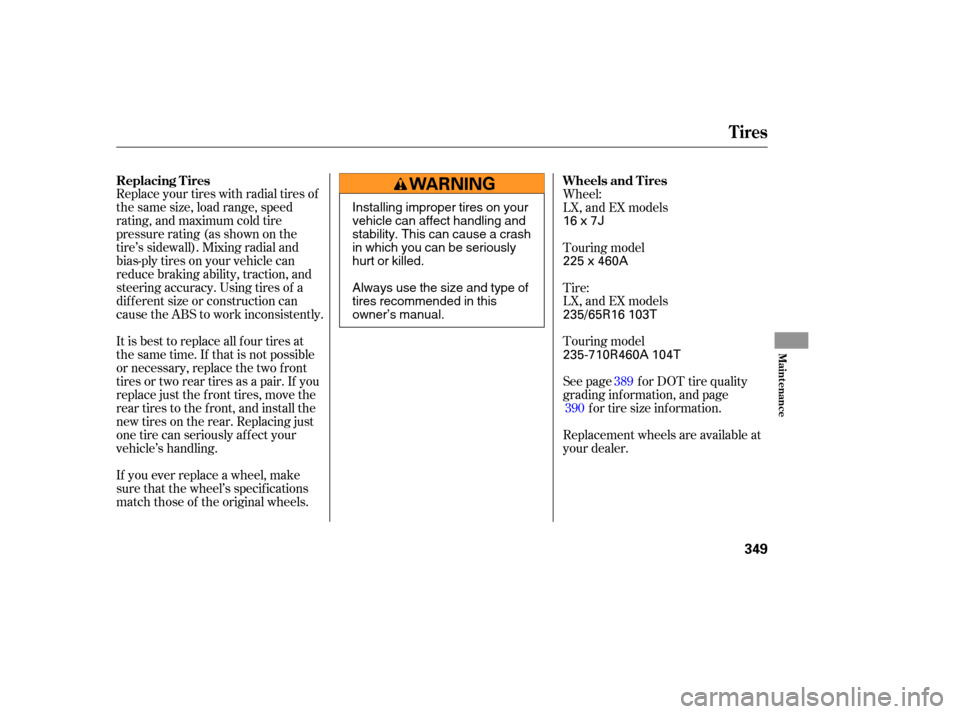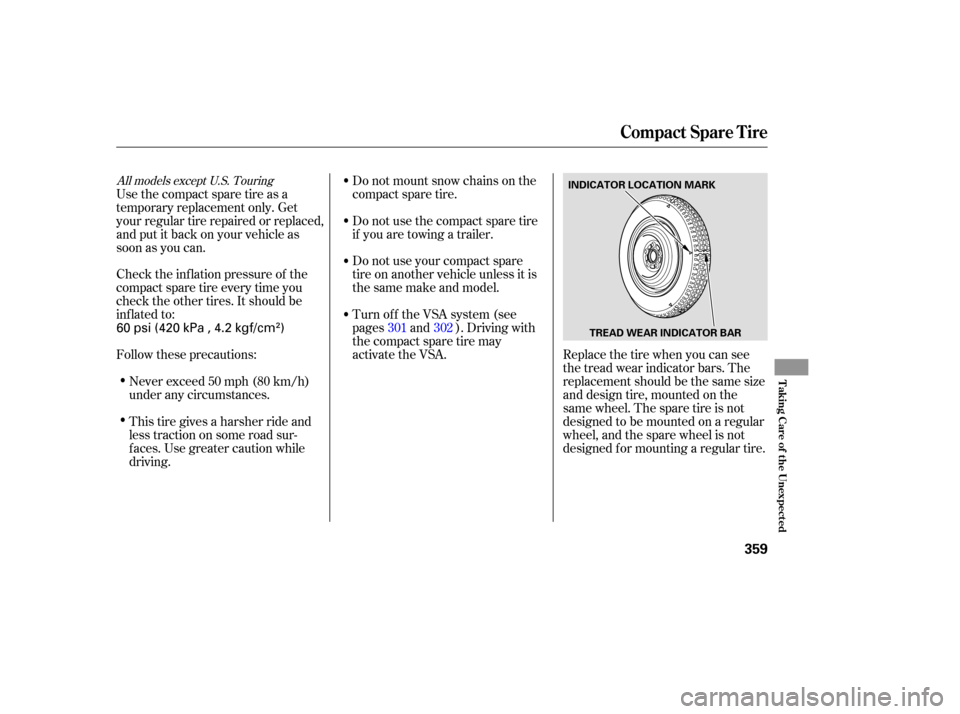Page 349 of 414

In addition to proper inf lation,
correct wheel alignment helps to
decrease tire wear. If you f ind a tire
is worn unevenly, have your dealer
check the wheel alignment.
Have your dealer check the tires if
you f eel a consistent vibration while
driving. A tire should always be
rebalanced if it is removed f rom the
wheel. When you have new tires
installed, make sure they are
balanced. This increases riding
comf ort and tire lif e. For best results,
have the installer perform a dynamic
balance.To help increase tire lif e and
distribute wear more evenly, rotate
the tires every 7,500 miles (12,000
km). Move the tires to the positions
showninthecharteachtimethey
are rotated. If you purchase
directional tires, rotate only f ront-to-
back.
Your vehicle’s tires have tread wear
indicators molded into the tread.
When the tread wears down to that
point, you will see a 1/2 inch (12.7
mm) wide band running across the
tread. This shows there is less than
1/16 inch (1.6 mm) of tread lef t on
the tire. A tire that is this worn gives
very little traction on wet roads. You
should replace the tire if you can see
the tread wear indicator in three or
more places around the tire.
On some models
Tires
T ire Maintenance
T ire Rotation
348
Front Front
(For Non-directional
Tires and Wheels) (For Directional
Tires and Wheels)
INDICATOR LOCATION MARKS
TREAD WEAR INDICATORS
Improper wheel weights can damage
your vehicle’s aluminum wheels. Use
only genuine Honda wheel weights f or
balancing.
Page 350 of 414

Replace your tires with radial tires of
the same size, load range, speed
rating, and maximum cold tire
pressure rating (as shown on the
tire’s sidewall). Mixing radial and
bias-ply tires on your vehicle can
reduce braking ability, traction, and
steering accuracy. Using tires of a
dif f erent size or construction can
cause the ABS to work inconsistently.See page f or DOT tire quality
grading inf ormation, and pagef or tire size inf ormation.
Replacement wheels are available at
your dealer.
It is best to replace all f our tires at
thesametime.If thatisnotpossible
or necessary, replace the two f ront
tires or two rear tires as a pair. If you
replace just the f ront tires, move the
rear tires to the front, and install the
new tires on the rear. Replacing just
onetirecanseriouslyaffectyour
vehicle’s handling.
If you ever replace a wheel, make
sure that the wheel’s specif ications
match those of the original wheels. Wheel:
Tire: LX, and EX models
Touring model
LX, and EX models
Touring model
389
390
Replacing T ires
Wheels and T ires
Tires
Maint enance
349
16x7J
235/65R16 103T 225 x 460A
235-710R460A 104T
Installing improper tires on your
vehicle can affect handling and
stability. This can cause a crash
in which you can be seriously
hurt or killed.
Always use the size and type of
tires recommended in this
owner’s manual.
Page 351 of 414

�´
Tires marked ‘‘M S’’ or ‘‘All
Season’’ on the sidewall have an all-
weather tread design suitable for
most winter driving conditions.
For the best perf ormance in snowy
or icy conditions, you should install
snow tires or tire chains. They may
be required by local laws under
certain conditions.
When installing cables, f ollow the
manuf acturer’s instructions, and
mount them as tight as you can.
Make sure they are not contacting
the brake lines or suspension. Drive
slowly with them installed. If you
hear them coming into contact with
the body or chassis, stop and
investigate. Remove them as soon as
you begin driving on cleared roads.
If you mount snow tires on your
vehicle, make sure they are radial
tires of the same size and load range
as original tires. Mount snow tires on
all f our wheels. The traction
provided by snow tires on dry roads
maybelowerthanyouroriginaltires.
Check with the tire dealer f or
maximum speed recommendations.
For snow tire inf ormation on the
Touring model, see page . Because your vehicle has limited tire
clearance, mount only SAE Class ‘‘S’’
cable-type traction devices, with
rubber chain tensioners on the f ront
tires. Use traction devices only when
required by driving conditions or
local laws. Make sure they are the
correct size f or your tires. Metal link-
type ‘‘chains’’ should not be used.
For tire chain inf ormation on the
Touring model, see page .
351 351
Tires
Winter Driving
Snow T iresTire Chains
350
Traction devices that are the wrong
size or improperly installed can
damage your vehicle’s brake lines,
suspension, body, and wheels. Stop
driving if they are hitting any part of
the vehicle.
Page 352 of 414

Your vehicle is equipped with the
Michelin PAX System which,
together with the Tire Pressure
Monitoring System (TPMS), enables
you to continue driving even if one or
more of your tires loses its pressure.
The tires and wheels on your vehicle
are specially designed f or the PAX
system, and the PAX system is
specif ically designed and f ine-tuned
foryourvehicle.
Because of these reasons, use only
the wheels and tires designated in
this owner’s manual. Never mix PAX
system wheels or tires with
conventional wheels or tires.There are no snow tires compatible
with the PAX system, and not all tire
chains are suitable f or use on the
PAX system tires. To prevent tire
chain damage to your PAX system
tire or wheel, ensure that no part of
the chain contacts the PAX system.
Never use a tire repair agent in a
PAX system tire, and never repair
a PAX system tire by yourself .
Repair or replacement must be
done a Honda dealer or an
authorized Michelin PAX system
dealer.
Do not replace the PAX system tires
and wheels with conventional tires
andwheels.Doingsowoulddisable
the PAX system and the tire
pressure monitoring system (TPMS),
and may void your new vehicle
warranty. If you must continue driving with a
f lat tire, f ollow all the procedures
and precautions described on page
.
356
On U.S. Touring model only
Tires
Michelin PA X SystemImport ant Precaut ions
Maint enance
351
Page 354 of 414

If you need to park your vehicle f or
an extended period (more than one
month), there are several things you
should do to prepare it f or storage.
Proper preparation helps prevent
deterioration and makes it easier to
get your vehicle back on the road. If
possible, store your vehicle indoors.Fill the f uel tank.
Change the engine oil and f ilter.
Wash and dry the exterior
completely.
Cleantheinterior.Makesurethe
carpeting, floor mats, etc., are
completely dry.
Leave the parking brake off. Put
the transmission in Park. Block the rear wheels.
If the vehicle is to be stored f or a
longer period, it should be
supported on jackstands so the
tires are of f the ground.
Leave one window open slightly (if
the vehicle is being stored
indoors).
Disconnect the battery.
Support the f ront and rear wiper
blade arms with a f olded towel or
ragsotheydonottouchthe
windshield.
To minimize sticking, apply a
silicone spray lubricant to all door
and tailgate seals. Also, apply a
vehiclebodywaxtothepainted
surfaces that mate with the door
and tailgate seals.Cover the vehicle with a
‘‘breathable’’ cover, one made
f rom a porous material such as
cotton. Non-porous materials, such
as plastic sheeting, trap moisture,
which can damage the paint.
If possible, periodically run the
engine until it reaches f ull
operating temperature (the
cooling f ans cycle twice).
Pref erably, do this once a month.
Vehicle Storage
Maint enance
353
Page 360 of 414

Replace the tire when you can see
the tread wear indicator bars. The
replacement should be the same size
and design tire, mounted on the
same wheel. The spare tire is not
designed to be mounted on a regular
wheel, and the spare wheel is not
designed f or mounting a regular tire.
Do not mount snow chains on the
compact spare tire.
Turn of f the VSA system (see
pages and ). Driving with
thecompactsparetiremay
activate the VSA. Do not use your compact spare
tire on another vehicle unless it is
thesamemakeandmodel. Do not use the compact spare tire
if you are towing a trailer.
This tire gives a harsher ride and
less traction on some road sur-
f aces. Use greater caution while
driving. Never exceed 50 mph (80 km/h)
under any circumstances.
Follow these precautions: Check the inf lation pressure of the
compact spare tire every time you
check the other tires. It should be
inf lated to: Use the compact spare tire as a
temporary replacement only. Get
your regular tire repaired or replaced,
and put it back on your vehicle as
soon as you can.
301 302
All models except U.S. Touring
Compact Spare T ire
T aking Care of t he Unexpect ed
359
INDICATOR LOCATION MARK
TREAD WEAR INDICATOR BAR
60 psi (420 kPa , 4.2 kgf/cm)
Page 362 of 414
The spare tire is stored behind a
cover on the sidewall of the cargo
area on the driver’s side.
Remove the cover by holding the
two handles and pulling the cover
out.
Unscrew the wing bolt, and take
the spare tire out of its holder.If you are changing a rear tire,
close the sliding door. Then turn
of f the sliding door MAIN switch.
Loosen each wheel nut 1/2 turn
with the wheel nut wrench.
Placethejackunderthejacking
point nearest the tire you need to
change. Turn the end bracket
clockwise until the top of the jack
contacts the jacking point. Make
sure the jacking point tab is
restinginthejacknotch.
5.
6. 7.
8.
9.
CONT INUED
On EX model
Changing a Flat T ire
T aking Care of t he Unexpect ed
361
WHEEL NUTS
Page 363 of 414
Use the extension and the wheel
nut wrench as shown to raise the
vehicle until the f lat tire is of f the
ground.
Remove the wheel nuts, then
remove the f lat tire. Handle the
wheel nuts caref ully; they may be
hot f rom driving. Place the f lat tire
on the ground with the outside
surface facing up.Do not attempt to forcibly pry the
wheel cover of f with a screwdriver or
other tool. The wheel cover cannot
be removed without f irst removing
the wheel nuts.
Bef ore mounting the spare tire,
wipe any dirt of f the mounting
surface of the wheel and hub with
a clean cloth. Wipe the hub
carefully;itmaybehotfrom
driving.
11. 10. 12.On LX model
Changing a Flat T ire
362
WHEEL
WRENCH
EXTENSION
WHEEL COVER
HAB